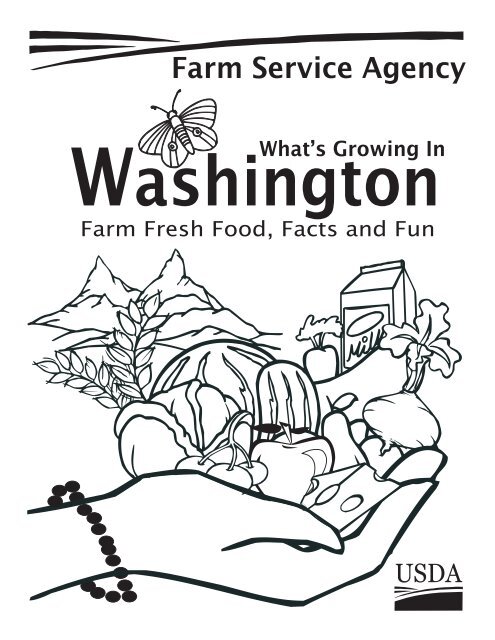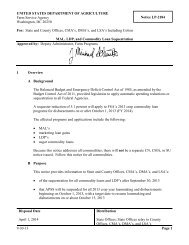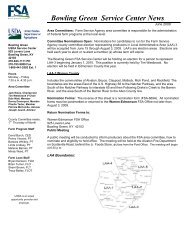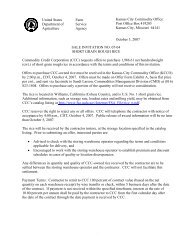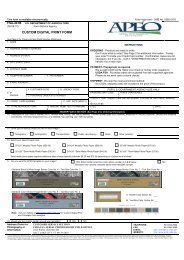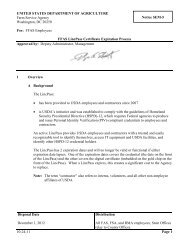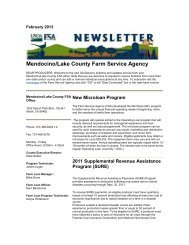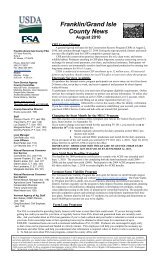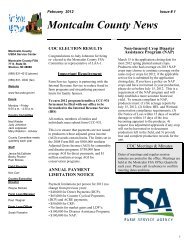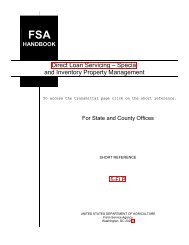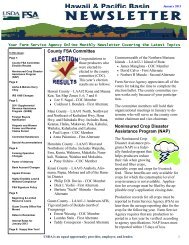coloring and activity book - USDA Farm Service Agency
coloring and activity book - USDA Farm Service Agency
coloring and activity book - USDA Farm Service Agency
You also want an ePaper? Increase the reach of your titles
YUMPU automatically turns print PDFs into web optimized ePapers that Google loves.
<strong>Farm</strong> <strong>Service</strong> <strong>Agency</strong><br />
What’s Growing In<br />
Washington<br />
<strong>Farm</strong> Fresh Food, Facts <strong>and</strong> Fun<br />
<strong>USDA</strong>
I bet it will be something good. And if it is hamburger, chicken,<br />
potatoes, peas or even apple pie, it’s a good bet that your food was<br />
grown not too far from where you live.<br />
Washington farmers <strong>and</strong> ranchers raise over 300 kinds of crops <strong>and</strong><br />
farm animals. Some you are familiar with, like apples, cows <strong>and</strong> wheat,<br />
but did you know Washington farmers also grow tulips, mushrooms,<br />
cranberries, lentils, cabbage seed, potatoes, soy beans, canola, hops,<br />
wine grapes, <strong>and</strong> many different kinds of grass <strong>and</strong> flower seeds?<br />
Washington is a growing place!<br />
Agriculture is the heart of Washington’s economy <strong>and</strong> provides more<br />
jobs than any other industry in the state. We are lucky to have good soil<br />
<strong>and</strong> plenty of water <strong>and</strong> sunshine for growing food in our state. And<br />
through our local conservation efforts, the <strong>Farm</strong> <strong>Service</strong> <strong>Agency</strong> is<br />
working with farmers <strong>and</strong> ranchers to keep it that way.<br />
I hope you will have fun with this <strong>activity</strong> <strong>book</strong>, <strong>and</strong> with it learn<br />
something about agriculture in the state. As we start to know about our<br />
food, we start to know about our farmers, who all work hard to fill our<br />
plates with delicious things to eat.<br />
So, what are you having for lunch? I bet it will be something grown<br />
in Washington. Washington farmers make our lives delicious!<br />
Judy Olson
Washington Grows Wheat!<br />
In fact, wheat is grown on more acres in Washington than any other crop. Whitman County is the<br />
number one wheat producing county in the nation.<br />
Wheat belongs to the cereal family of plants,<br />
which also includes rye, corn, oats <strong>and</strong> rice.<br />
Several different kinds of wheat are grown<br />
here, but more than 80% is soft white wheat,<br />
the kind used in pancakes, cookies, cakes,<br />
crackers, flat breads <strong>and</strong> cereals.<br />
Hard red wheat is used for hard rolls, <strong>and</strong><br />
bagels, while hard white wheat is used for things like Asian-style noodles. Durham wheat is used<br />
for making different kinds of pasta.<br />
Washington <strong>Farm</strong> <strong>Service</strong> <strong>Agency</strong>
Washington’s Got Milk!<br />
Washington ranks 10th in total milk production in the U.S.<br />
There are about 241,000 dairy cows in Washington. Dairy<br />
farms are found in 18 Washington counties, but Yakima,<br />
Whatcom <strong>and</strong> Skagit counties produce the most milk.<br />
Did you know that one dairy cow can produce enough milk each<br />
year to fill a bath tub more than 40 times? That is enough milk<br />
for 60 people to drink in one year.<br />
At the grocery store milk is sold by the pint, quart or gallon, but in the dairy industry, milk is<br />
measured by the pound. It takes 21.2 pounds of whole milk to make one pound of butter, <strong>and</strong> 12<br />
pounds of whole milk to make one gallon of ice cream.<br />
Washington grows hay for dairy cows to eat. Hay is grass or other vegetation that is cut, dried <strong>and</strong><br />
stored to use as food for cattle, horses, goats, sheep <strong>and</strong> other animals.<br />
www.fsa.usda.gov/wa
Washington Grows Apples!<br />
In fact, Washington grows more apples<br />
than any other state. If you took all of the<br />
apples picked in Washington in one year<br />
<strong>and</strong> put them side-by-side, they would circle<br />
the Earth 12 times!<br />
Apple harvest begins in mid-August <strong>and</strong><br />
generally ends in early November. Each<br />
year Washington growers harvest between<br />
10 - 12 billion apples.<br />
Did you know that each Washington<br />
apple is picked by h<strong>and</strong> because there are<br />
no harvest machines to pick apples!<br />
How Much Do You Know About Apples?<br />
1. How many different apple varieties are there in the world?<br />
a) 25 b) 750 c) 7,500 d) 10,000<br />
2. Apples can only be harvested by<br />
a) people b) picking machines c) robots<br />
3. How many seeds are in an average apple?<br />
a) 9 b) 16 c) 5 d) none<br />
4. Which state grows the most apples in the U.S.?<br />
a) Virginia b) California c) Texas d) Washington<br />
5. In one year, how many pounds of fresh apples does the average American eat?<br />
a) 3 lbs. b) 5 lbs. c) 8 lbs. d) 17 lbs.<br />
(answers on last page)<br />
Washington <strong>Farm</strong> <strong>Service</strong> <strong>Agency</strong>
Washington Grows Fruit<br />
Apples may be the top fruit crop in Washington, but lots of other fruits are grown here, like cherries,<br />
pears <strong>and</strong> peaches. In fact, Washington is first in the nation for sweet cherries, <strong>and</strong> Yakima <strong>and</strong> Chelan<br />
counties grow the most. Did you know that fresh cherries<br />
can not be kept in storage, that is why you only find them<br />
in the grocery store in the late spring <strong>and</strong> summer?<br />
Washington pears are usually available all<br />
year-round. There are two types of<br />
pears - winter pears <strong>and</strong> Asian<br />
pears. When ripe, winter pears<br />
get soft, sweet <strong>and</strong> juicy, but<br />
Asian pears are crunchy.<br />
Winter pears ripen best after<br />
they are harvested.<br />
Fruity Word Search<br />
All of these fruits are grown in Washington<br />
State. Can you find them in the word search?<br />
Hint: Some words share letters.<br />
APRICOTS<br />
BLUEBERRIES<br />
CANTALOUPE<br />
CHERRIES<br />
CRANBERRIES<br />
GRAPES<br />
NECTARINES<br />
PEACHES<br />
(answers on last page)<br />
www.fsa.usda.gov/wa<br />
PEARS<br />
PLUMS<br />
PLUOTS<br />
PRUNES<br />
RASPBERRIES<br />
STRAWBERRIES<br />
WATERMELON<br />
U R J P O I U K H D Y O B E T<br />
M O G G Z B X E D E X I K M A<br />
W A T E R M E L O N T T R A S<br />
O P P C D Z F P E A C H E S C<br />
B A E M A D B H Q O I Y H H E<br />
S T R A W B E R R I E S E S M<br />
S E I R R E B E U L B R E A F<br />
R P S R U X C W U N R I R S D<br />
N A U T N R I P E I R I E U Z<br />
S K S S O R X C E R O P H I E<br />
S E F P P C T S E N U I P N Y<br />
S E I T B A I B Y O S N E A G<br />
Y T S R R E N R L G S A A Y R<br />
S N O I R A R A P I P I R P E<br />
U Y N U R E T R W A H L S R D<br />
S E D C L N B O I M U A U U E<br />
S M J N A P T D D E H T L N H<br />
J X U C G R A P E S S I U E V<br />
B Y J L E X Z U Q T B F O S I<br />
I N R M P B D M D W R L B B J
Washington Grows Beef<br />
There are about 13,000 ranchers <strong>and</strong> cattlemen in Washington <strong>and</strong> they raise over 640 million<br />
pounds of beef each year that go into the foods we enjoy for lunch <strong>and</strong> dinner. The new <strong>USDA</strong> food<br />
pyramid recommends eating 5 ½ ounces of protein each day, which includes lean meats <strong>and</strong> beans.<br />
Who invented the hamburger? Nobody knows for sure, but the Hamburger Hall of Fame in<br />
Seymour, Wisconsin claims it was "Hamburger Charlie," a local young man who, in 1885, was having<br />
a hard time selling meatballs at the county fair - too messy, so he flattened them out <strong>and</strong> put them<br />
between two slices of bread <strong>and</strong> called it a hamburger.<br />
Washington <strong>Farm</strong> <strong>Service</strong> <strong>Agency</strong>
Washington Grows Fish<br />
Fish farming, or aquaculture, is a growing business in Washington.<br />
Aquaculture is the raising of aquatic animals <strong>and</strong> plants under<br />
controlled conditions. Fish farmers help to provide a<br />
consistent source of quality food for commercial use,<br />
tribal <strong>and</strong> recreational harvest, <strong>and</strong> for restocking<br />
depleted rivers <strong>and</strong> lakes.<br />
Washington has over 200 fish farms. Products include<br />
Atlantic <strong>and</strong> Steelhead salmon, trout, oysters, mussels,<br />
<strong>and</strong> clams. Oyster <strong>and</strong> farmed salmon production make<br />
Washington one of the top producing states in the U.S.<br />
Washington Grows Energy<br />
Renewable energy comes from sources that can’t be used up or are easy to replace, like sunlight,<br />
wind, water, <strong>and</strong> biofuels. While the amount of renewable energy produced today is small, the<br />
potential is enormous. More Washington farmers are<br />
www.fsa.usda.gov/wa<br />
becoming involved with the production of biocrops, such<br />
as corn <strong>and</strong> canola that can be processed <strong>and</strong> turned into<br />
fuel for cars, trucks <strong>and</strong> farm equipment
Washington <strong>Farm</strong> Fresh Crossword Puzzle<br />
All of the clues for this puzzle are found in this <strong>coloring</strong> <strong>and</strong> <strong>activity</strong> <strong>book</strong>. Have fun!<br />
1<br />
Across<br />
1. Red <strong>and</strong> juicy<br />
3. Works on a ranch<br />
7. Works on a farm<br />
9. Wheat with cheese <strong>and</strong> sauce<br />
10. Woolly animal<br />
13. Frozen treat<br />
W<br />
3<br />
7 8<br />
F<br />
9<br />
10 11 12<br />
H<br />
R<br />
2<br />
13<br />
I<br />
4<br />
Down<br />
2. Works in the field<br />
4. Milk maker<br />
5. Wheat by the slice<br />
6. Red, round <strong>and</strong> sweet<br />
8. Red <strong>and</strong> delicious<br />
11. Feed for animals<br />
12. Animal with curly tail<br />
5<br />
6<br />
B C<br />
E<br />
Washington <strong>Farm</strong> <strong>Service</strong> <strong>Agency</strong>
Animal Parade<br />
You can find all of these animals <strong>and</strong> insects on farms in Washington. Can you name them?<br />
C __ __ H __ __ __ __ __ T __ __ __ __ __<br />
R __ __ __ __ __<br />
www.fsa.usda.gov/wa<br />
P __ __ C __ __<br />
S __ __ __ __ D __ __ __ __ __ M __ __ __ __<br />
B __ __ S __ __ __ __ L __ __ __ __<br />
(answers on last page)
Washington grows flowers!<br />
You may not think of flowers <strong>and</strong> plants as crops, but as the<br />
number of family farms in the U.S. is decreasing, the number of<br />
nursery <strong>and</strong> greenhouse farms is increasing. The U.S. is the<br />
world’s largest producer of plants <strong>and</strong> flowers, which is a<br />
growing part of agriculture. Washington ranks third in the<br />
nation in the sale of cut flowers <strong>and</strong> fresh greenery.<br />
In addition to tulips, lilies, <strong>and</strong> other fussy flowers,<br />
Washington grows over 2,300 different kinds of<br />
decorative native plants <strong>and</strong> grasses. Native plants are<br />
the kind that filled the fields <strong>and</strong> woods long before the<br />
first settlers came to America. Native plants are good for the environment because they need less<br />
water, require no pesticides, <strong>and</strong> provide food <strong>and</strong> shelter for wildlife.<br />
Washington <strong>Farm</strong> <strong>Service</strong> <strong>Agency</strong>
Bees And Worms In Your Food<br />
Earthworms are good for the soil. <strong>Farm</strong>ers <strong>and</strong> earthworms work together to grow your food.<br />
Earthworms help to turn ordinary dirt into rich nutritious garden<br />
soil where plants love to grow. Thank a worm for your lunch!<br />
Worm Trivia<br />
Answer True (T) or False (F)<br />
1. If a worm’s skin dries out, it will die? (T or F)<br />
2. Worms have eyes? (T or F)<br />
3. A worm has 6 very tiny legs? (T or F)<br />
4. Worms eat as much as they weigh in one day. (T or F)<br />
5. In one acre of l<strong>and</strong>, there can be more than a million<br />
earthworms. (T or F)<br />
(answers on last page)<br />
Honey bees play an essential role in agriculture, not only producing honey <strong>and</strong> beeswax but also<br />
pollinating a vast number of food crops. Bees work hard to put fruit in your lunch bag.<br />
Honey Bee Trivia<br />
1. How many legs does a bee have?<br />
a) 2 b) 4 c) 6<br />
2. How far can a bee fly in one trip?<br />
a) 1 mile b) 5 miles c) 8 miles<br />
3. Bees do NOT<br />
a) eat b) sleep c) dance<br />
4. How many flowers must a honey bee<br />
visit to make one pound of honey?<br />
a) 2 million b) 2 thous<strong>and</strong> c) 2 dozen<br />
5. Bees are found everywhere except<br />
a) Alaska b) Antarctica c) Seattle<br />
(answers on last page)<br />
www.fsa.usda.gov/wa<br />
Help The Find The Flower<br />
start
Conservation Works In Washington<br />
The <strong>Farm</strong> <strong>Service</strong> <strong>Agency</strong> works with Washington’s farmers <strong>and</strong> ranchers to protect soil, water,<br />
forests, fish <strong>and</strong> wildlife. In fact, our Conservation Reserve Program is America’s largest <strong>and</strong> most<br />
successful conservation program on private l<strong>and</strong>. Grasses <strong>and</strong> other plants provide food <strong>and</strong> shelter<br />
for wildlife, like the Northern Bobwhite Quail. Each year 750,000 more Northern Bobwhite Quail are<br />
born as a result of the success of farmers’ efforts <strong>and</strong> the Conservation Reserve Program.<br />
Quail Match Game<br />
Each bird on the top row has an exact match on the bottom row. Can you find which pairs match?<br />
Just For Laughs<br />
A B C<br />
D E F<br />
(answers on last page)<br />
How can you spot a dogwood tree? By its bark!....What do you call a clever duck? A<br />
wise quacker!....What’s a snake’s favorite subject? Hiss-tory!....What’s smarter than<br />
a hummingbird? A spelling bee!....When is a car like a frog? When it’s being toad.<br />
What do you give a sick bird? Tweetment!....What did the frog order at the drive- thru?<br />
Flies <strong>and</strong> a croak!.......What did summer say to spring? Help, I’m going to fall!<br />
Washington <strong>Farm</strong> <strong>Service</strong> <strong>Agency</strong>
U R J P O I U K H D Y O B E T<br />
M O G G Z B X E D E X I K M A<br />
W A T E R M E L O N T T R A S<br />
O P P C D Z F P E A C H E S C<br />
B A E M A D B H Q O I Y H H E<br />
S T R A W B E R R I E S E S M<br />
S E I R R E B E U L B R E A F<br />
R P S R U X C W U N R I R S D<br />
N A U T N R I P E I R I E U Z<br />
S K S S O R X C E R O P H I E<br />
S E F P P C T S E N U I P N Y<br />
S E I T B A I B Y O S N E A G<br />
Y T S R R E N R L G S A A Y R<br />
S N O I R A R A P I P I R P E<br />
U Y N U R E T R W A H L S R D<br />
S E D C L N B O I M U A U U E<br />
S M J N A P T D D E H T L N H<br />
J X U C G R A P E S S I U E V<br />
B Y J L E X Z U Q T B F O S I<br />
I N R M P B D M D W R L B B J<br />
Cow Horse<br />
Turkey<br />
Rabbit<br />
Pig Cat<br />
Sheep Donkey<br />
Mouse<br />
Bee Skunk Llama<br />
Apple Answers<br />
1) d 2) a 3) c 4) d 5) d<br />
Worm Trivia<br />
1) True 2) False 3) False 4) True 5) True<br />
Honey Bee Trivia<br />
1) c 2) c 3) b 4) a 5) b<br />
1<br />
A B C<br />
D E F<br />
2<br />
W A T E R M E L O N<br />
7 8<br />
3<br />
4<br />
R A N C H E R<br />
9<br />
R<br />
C<br />
T<br />
O<br />
10 11 12<br />
13<br />
O<br />
W<br />
F A R M E R<br />
P<br />
P<br />
L<br />
I Z Z<br />
S H E E P<br />
A<br />
Y G<br />
5<br />
B<br />
E<br />
A<br />
D<br />
C<br />
H<br />
E<br />
R<br />
R<br />
I C E C R E A M<br />
I<br />
S<br />
6
About The <strong>Farm</strong> <strong>Service</strong> <strong>Agency</strong><br />
The <strong>Farm</strong> <strong>Service</strong> <strong>Agency</strong> (FSA) administers <strong>and</strong> manages farm commodity, credit, conservation,<br />
disaster <strong>and</strong> loan programs as part of the United States Department of Agriculture. FSA provides the<br />
financial assistance that helps sustain <strong>and</strong> grow American agriculture.<br />
Commodity Payments <strong>and</strong> Economic Stability:<br />
These programs are designed to improve the economic stability of the agricultural industry <strong>and</strong> to<br />
help farmers provide a safe, wholesome, nutritious <strong>and</strong> affordable food <strong>and</strong> fiber supply for consumers.<br />
Economically, the desired result of these programs is a steady price range for agricultural commodities<br />
for both farmers <strong>and</strong> consumers.<br />
<strong>Farm</strong> Loan And Emergency Loan Programs:<br />
In addition to farm payments, FSA provides direct <strong>and</strong> guaranteed loan assistance to farmers <strong>and</strong><br />
ranchers at all stages in their operation. Loans can be used to purchase farml<strong>and</strong>, livestock, feed<br />
<strong>and</strong> equipment as well as construct or repair buildings <strong>and</strong> other fixtures, <strong>and</strong>/or develop farml<strong>and</strong> to<br />
promote soil <strong>and</strong> water conservation. Emergency <strong>Farm</strong> Loans provide assistance to help producers<br />
recover from production <strong>and</strong> physical losses due to natural disasters or quarantine.<br />
Through its Beginning <strong>Farm</strong>er <strong>and</strong> Rancher Loan Program <strong>and</strong> the Socially Disadvantaged<br />
<strong>Farm</strong>er <strong>and</strong> Rancher Loan Program, FSA offers targeted assistance to producers just starting out<br />
who want to buy <strong>and</strong> operate a family-size farm or ranch but are unable to obtain financing from<br />
commercial credit sources.<br />
FSA also supports the future of agriculture through its Rural Youth Loan Program. Targeted<br />
toward rural youth between 10 <strong>and</strong> 20 years old, the <strong>Farm</strong> <strong>Service</strong> <strong>Agency</strong> makes loans to boys <strong>and</strong><br />
girls in rural communities who want to start learning about the business of agriculture.<br />
The Youth Loan Program is designed to provide start-up capital to establish <strong>and</strong> operate incomeproducing<br />
projects of modest size in connection with participation in 4-H clubs, Future <strong>Farm</strong>ers of<br />
America, <strong>and</strong> similar agriculture focused organizations.<br />
Conservation:<br />
FSA supports conservation efforts through its Conservation Reserve Program (CRP). Through<br />
CRP, farmers <strong>and</strong> ranchers plant grasses, trees, <strong>and</strong> other vegetation next to crop fields <strong>and</strong><br />
streams. They also install wetl<strong>and</strong>s, grass waterways, <strong>and</strong> other conservation structures on their<br />
l<strong>and</strong>. CRP plantings <strong>and</strong> structures keep soil from eroding into our waterways or contaminating our<br />
air. CRP plantings also improve water quality by filtering out agricultural nutrients <strong>and</strong> removing<br />
carbon from the atmosphere.<br />
Learn More:<br />
To find out more about FSA, its programs <strong>and</strong> requirements, please visit your local FSA office or<br />
<strong>USDA</strong> <strong>Service</strong> Center, or you can find us on line at www.fsa.usda.gov<br />
The United States Department of Agriculture (<strong>USDA</strong>) prohibits discrimination in its programs on the basis of race, color, national origin, sex, religion,<br />
age, disability, political beliefs, sexual orientation, or marital or familial status (Not all prohibited bases apply to all programs.) Persons with disabilities<br />
who require alternative means for communication of program information (braille, large print, audiotape, etc. should contact <strong>USDA</strong>’s TARGET Center at<br />
(202) 720-2600 (voice <strong>and</strong> TDD). To file a complaint of discrimination, write <strong>USDA</strong>, Director, Office of Civil Rights, Room 326- W, Whiten Building, 1400<br />
Independence Avenue, SW, Washington, D.C., 20250-9410, or call (202) 720-5964 (voice <strong>and</strong> TDD). <strong>USDA</strong> is an equal opportunity employer.
Contains One U.S. Bushel By Volume<br />
Orchard Best<br />
Orchard Best<br />
Grown <strong>and</strong> Packed By Orchard <strong>Farm</strong>s, Yakima, Wash.<br />
Washington State Apples<br />
Did You Know? Before the use of mass produced cardboard boxes, fruit growers, packers <strong>and</strong> shippers printed labels <strong>and</strong> attached<br />
them to wooden fruit crates or boxes used to ship their fruit to market. Today these old labels are highly prized <strong>and</strong> very collectable.


